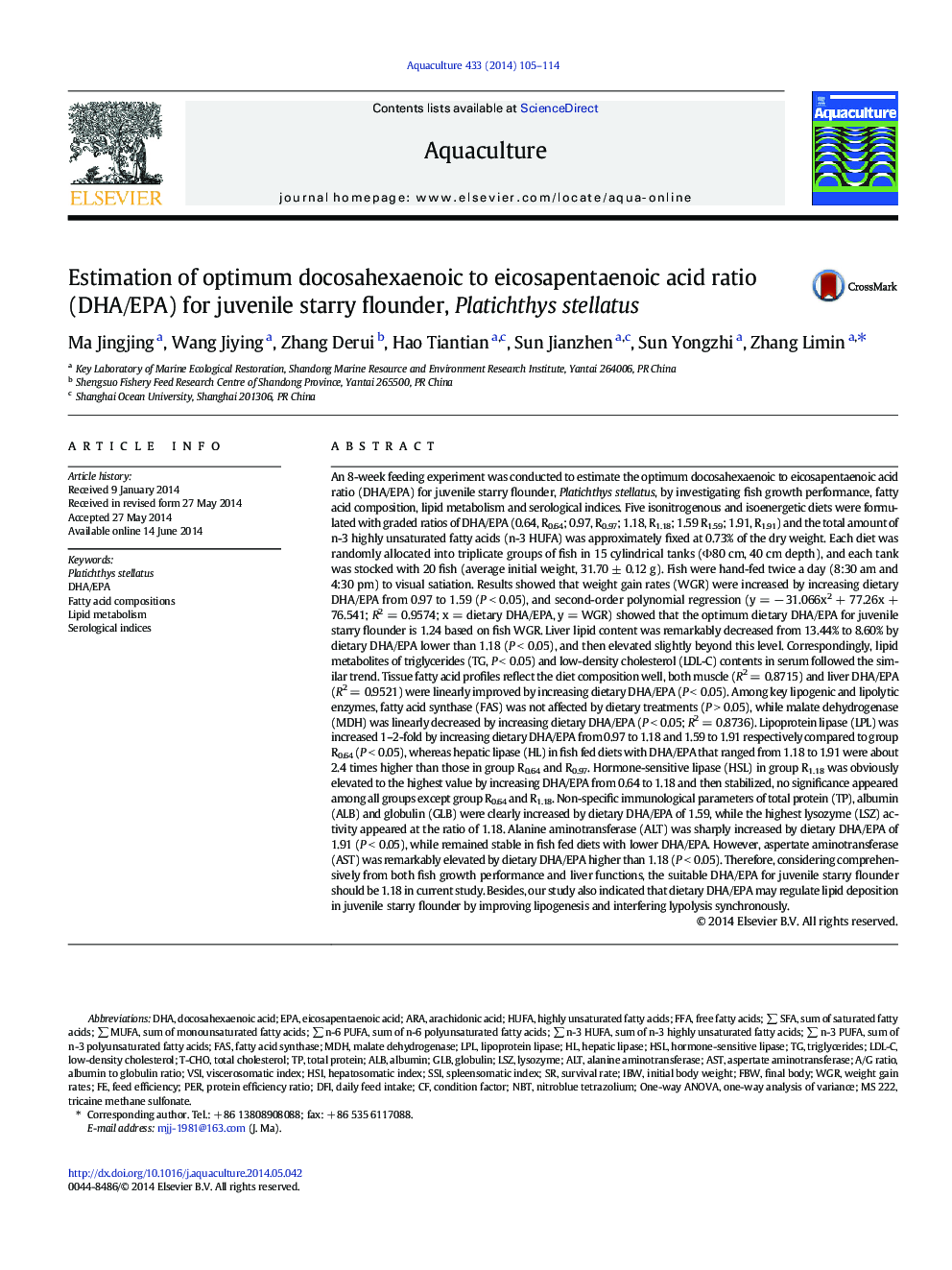| کد مقاله | کد نشریه | سال انتشار | مقاله انگلیسی | نسخه تمام متن |
|---|---|---|---|---|
| 2421876 | 1552854 | 2014 | 10 صفحه PDF | دانلود رایگان |

• DHA is superior to EPA in promoting growth performance of juvenile starry flounder.
• Optimum DHA/EPA ratio for juvenile starry flounder is 1.18 in current study.
• DHA/EPA affects fish lipid deposition by regulating lipogenic and lipolytic enzymes.
An 8-week feeding experiment was conducted to estimate the optimum docosahexaenoic to eicosapentaenoic acid ratio (DHA/EPA) for juvenile starry flounder, Platichthys stellatus, by investigating fish growth performance, fatty acid composition, lipid metabolism and serological indices. Five isonitrogenous and isoenergetic diets were formulated with graded ratios of DHA/EPA (0.64, R0.64; 0.97, R0.97; 1.18, R1.18; 1.59 R1.59; 1.91, R1.91) and the total amount of n-3 highly unsaturated fatty acids (n-3 HUFA) was approximately fixed at 0.73% of the dry weight. Each diet was randomly allocated into triplicate groups of fish in 15 cylindrical tanks (Φ80 cm, 40 cm depth), and each tank was stocked with 20 fish (average initial weight, 31.70 ± 0.12 g). Fish were hand-fed twice a day (8:30 am and 4:30 pm) to visual satiation. Results showed that weight gain rates (WGR) were increased by increasing dietary DHA/EPA from 0.97 to 1.59 (P < 0.05), and second-order polynomial regression (y = − 31.066x2 + 77.26x + 76.541; R2 = 0.9574; x = dietary DHA/EPA, y = WGR) showed that the optimum dietary DHA/EPA for juvenile starry flounder is 1.24 based on fish WGR. Liver lipid content was remarkably decreased from 13.44% to 8.60% by dietary DHA/EPA lower than 1.18 (P < 0.05), and then elevated slightly beyond this level. Correspondingly, lipid metabolites of triglycerides (TG, P < 0.05) and low-density cholesterol (LDL-C) contents in serum followed the similar trend. Tissue fatty acid profiles reflect the diet composition well, both muscle (R2 = 0.8715) and liver DHA/EPA (R2 = 0.9521) were linearly improved by increasing dietary DHA/EPA (P < 0.05). Among key lipogenic and lipolytic enzymes, fatty acid synthase (FAS) was not affected by dietary treatments (P > 0.05), while malate dehydrogenase (MDH) was linearly decreased by increasing dietary DHA/EPA (P < 0.05; R2 = 0.8736). Lipoprotein lipase (LPL) was increased 1–2-fold by increasing dietary DHA/EPA from 0.97 to 1.18 and 1.59 to 1.91 respectively compared to group R0.64 (P < 0.05), whereas hepatic lipase (HL) in fish fed diets with DHA/EPA that ranged from 1.18 to 1.91 were about 2.4 times higher than those in group R0.64 and R0.97. Hormone-sensitive lipase (HSL) in group R1.18 was obviously elevated to the highest value by increasing DHA/EPA from 0.64 to 1.18 and then stabilized, no significance appeared among all groups except group R0.64 and R1.18. Non-specific immunological parameters of total protein (TP), albumin (ALB) and globulin (GLB) were clearly increased by dietary DHA/EPA of 1.59, while the highest lysozyme (LSZ) activity appeared at the ratio of 1.18. Alanine aminotransferase (ALT) was sharply increased by dietary DHA/EPA of 1.91 (P < 0.05), while remained stable in fish fed diets with lower DHA/EPA. However, aspertate aminotransferase (AST) was remarkably elevated by dietary DHA/EPA higher than 1.18 (P < 0.05). Therefore, considering comprehensively from both fish growth performance and liver functions, the suitable DHA/EPA for juvenile starry flounder should be 1.18 in current study. Besides, our study also indicated that dietary DHA/EPA may regulate lipid deposition in juvenile starry flounder by improving lipogenesis and interfering lypolysis synchronously.
Journal: Aquaculture - Volume 433, 20 September 2014, Pages 105–114